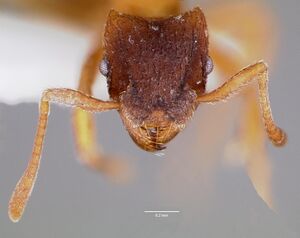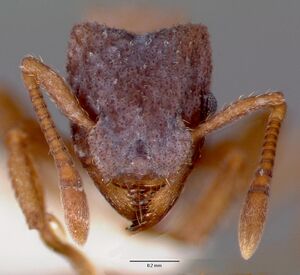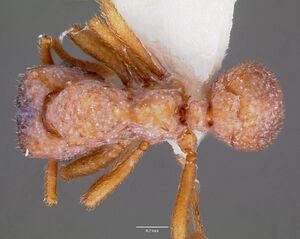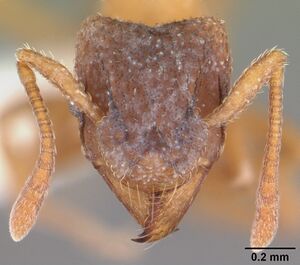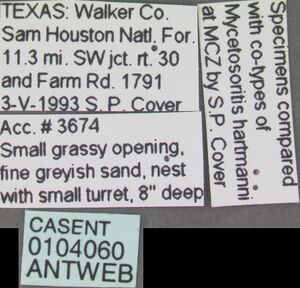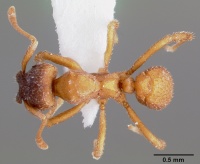| For additional details see Fungus growing ants.
A handful of ant species (approx. 275 out of the known 15,000 species) have developed the ability to cultivate fungus within their nests. In most species the fungus is used as the sole food source for the larvae and is an important resource for the adults as well. Additionally, in a limited number of cases, the fungus is used to construct part of the nest structure but is not as a food source.
These fungus-feeding species are limited to North and South America, extending from the pine barrens of New Jersey, United States, in the north (Trachymyrmex septentrionalis) to the cold deserts in Argentina in the south (several species of Acromyrmex). Species that use fungi in nest construction are known from Europe and Africa (a few species in the genera Crematogaster, Lasius).
The details of fungal cultivation are rich and complex. First, a wide variety of materials are used as substrate for fungus cultivating. The so-called lower genera include species that prefer dead vegetation, seeds, flowers, fruits, insect corpses, and feces, which are collected in the vicinity of their nests. The higher genera include non leaf-cutting species that collect mostly fallen leaflets, fruit, and flowers, as well as the leafcutters that collect fresh leaves from shrubs and trees. Second, while the majority of fungi that are farmed by fungus-feeding ants belong to the family Lepiotaceae, mostly the genera Leucoagaricus and Leucocoprinus, other fungi are also involved. Some species utilise fungi in the family Tricholomataceae while a few others cultivate yeast. The fungi used by the higher genera no longer produce spores. Their fungi produce nutritious and swollen hyphal tips (gongylidia) that grow in bundles called staphylae, to specifically feed the ants. Finally, colony size varies tremendously among these ants. Lower taxa mostly live in inconspicuous nests with 100–1000 individuals and relatively small fungus gardens. Higher taxa, in contrast, live in colonies made of 5–10 million ants that live and work within hundreds of interconnected fungus-bearing chambers in huge subterranean nests. Some colonies are so large, they can be seen from satellite photos, measuring up to 600 m3.
Based on these habits, and taking phylogenetic information into consideration, these ants can be divided into six biologically distinct agricultural systems (with a list of genera involved in each category):
Nest Construction
A limited number of species that use fungi in the construction of their nests.
Lower Agriculture
Practiced by species in the majority of fungus-feeding genera, including those thought to retain more primitive features, which cultivate a wide range of fungal species in the tribe Leucocoprineae.
Coral Fungus Agriculture
Practiced by species in the Apterostigma pilosum species-group, which cultivate fungi within the Pterulaceae.
Yeast Agriculture
Practiced by species within the Cyphomyrmex rimosus species-group, which cultivate a distinct clade of leucocoprineaceous fungi derived from the lower attine fungi.
Generalized Higher Agriculture
Practiced by species in several genera of non-leaf-cutting "higher attine" ants, which cultivate a distinct clade of leucocoprineaceous fungi separately derived from the lower attine fungi.
Leaf-Cutter Agriculture
A subdivision of higher attine agriculture practiced by species within several ecologically dominant genera, which cultivate a single highly derived species of higher attine fungus.
Note that the farming habits of Mycetagroicus (4 species) are unknown. Also, while species of Pseudoatta (2 species) are closely related to the fungus-feeding genus Acromyrmex, they are social parasites, living in the nests of their hosts and are not actively involved in fungus growing.
| 








